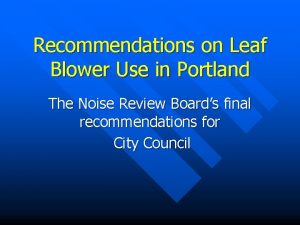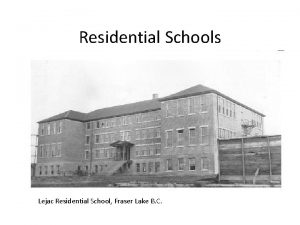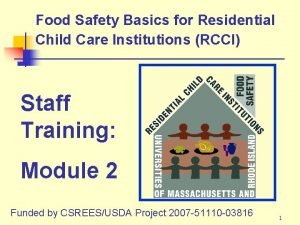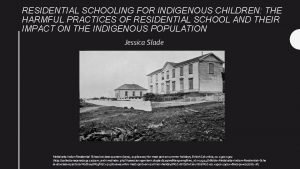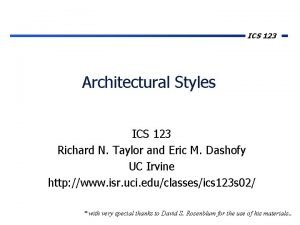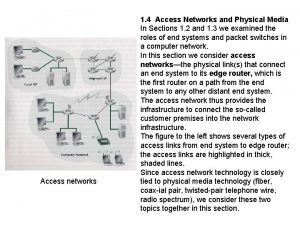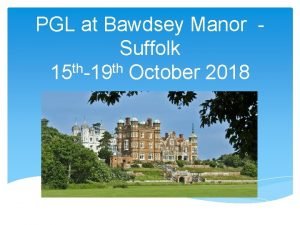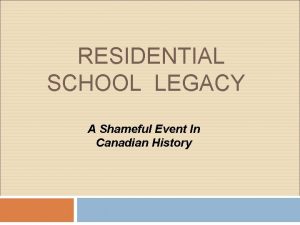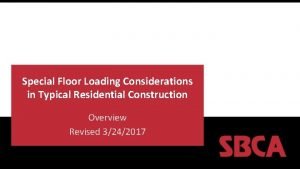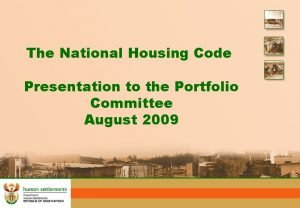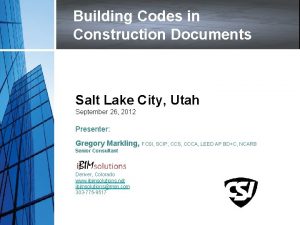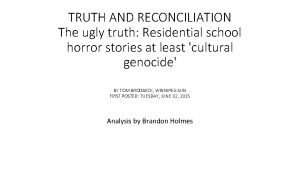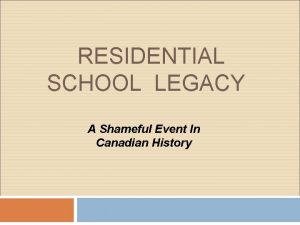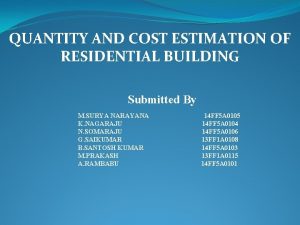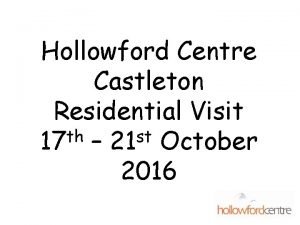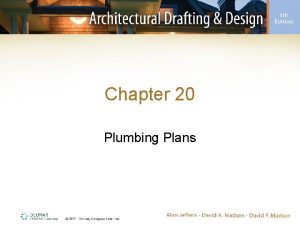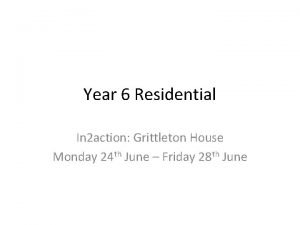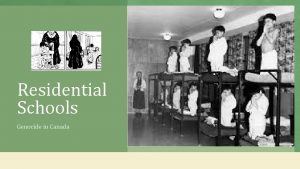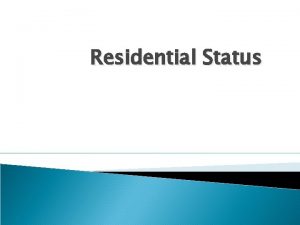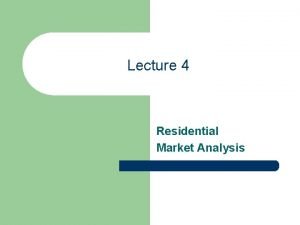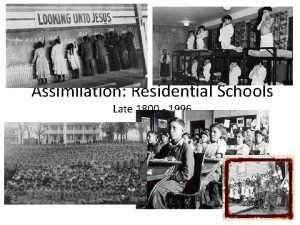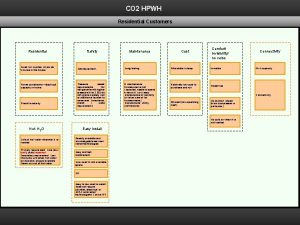Settlement Settlement A collection of residential properties Individual










































- Slides: 42

Settlement



Settlement A collection of residential properties Individual houses Rural settlement Village Town City Megacity

Settlement Timeline 1. The Hunter-Gatherers of Mount Sandel 2. The New Stone Age Settlers -Neolithic 3. Celts 4. Early Christian Monastic Settlements 5. The Vikings 5. The Normans 6. Later Monastic Settlements – after 1100 AD 7. Plantation Towns – 16 th – 17 th Century 8. Landlord Towns – 17 th Century 9. Modern settlement

Who When Where from Where to Evidence Survived Stone age 7000 BC Britain Coast Little evidence as settlements moved Hunter gatherer Neolithic 5000 BC Britain & Ibernian pennisula Coast and river side sites Middens (shells & bones in heaps). Fulacht fia. Tombs, court cairns, dolmens and passage graves. Farming Celts 800 BC Mainland Europe Hillside sites Headlands Lake side sites Ringforts Hill forts Promotory forts Crannogs Ringforts Farming Monastic settlements 400 AD Celts converted to Christanity Glendalough Clonmacnoise Round tower Burial grounds Farming Vikings 700 AD Scandanavia Bays & estuaries Placenames with Ford (fjord) and low (lowland) Trading Norman 1100 AD Britain Former viking Castles settlements easily defended areas. Farming, trade in markets Plantation 1500 Britain 1600 AD Fertile land Farming , trade in markets Large estates, market squares in towns

Where did we come from? Where from Defence Water Communications Food

The First Settlers in Ireland • The first people who settled in Ireland were the Hunter-Gatherers of Mount Sandel. • They arrived in Ireland about 9000 years ago, and settled beside the River Bann.

Why did they settle in Mount Sandel? • • • They used the water from the River Bann for cooking, and washing. They used the river as a transport route. There were no roads. They also caught fish in the river food. They got flint for their stone weapons in Co. Antrim. They hunted wild pigs and deer in the forests. They gathered nuts and fruits in the forests. Therefore, Mount Sandel was a good place for them to live because it provided them with all of the things they needed in their lives.

New Stone Age Settlers – The Boyne Valley • The New Stone Age (Neolithic) settlers arrived in Ireland around 4000 BC. • Their lives differed from the hunter-gatherers in one important way. These people had started to keep animals and plant crops. In other words, they had started farming. • They settled in the Boyne Valley because; – The River Boyne was a transport and communication route. – They got water from the river, as well as fish. – The soils in the Boyne Valley are fertile and so they are good for farming. – They could hunt deer and other animals in the forests if they needed food.

Location of Pre-Christian settlement food and water • Pre-Christian settlers chose to settle near a water supply such as a river, lake or estuary. • The first settlers in Ireland survived as hunter-gatherers. • They did not grow crops. Instead they hunted animals and fish and gathered berries and nuts. • Middens – heaps of discarded shells and animal bones – provide evidence of early settlements. • After 5, 000 BC, new Stone Age settlers brought seeds to Ireland began to farm the land. • These settlers cooked meat in water-filled troughs called fulachta fiadh. • Evidence of Stone Age settlements includes burial sites such as megalithic tombs, court cairns, dolmens and passage graves.

Location of Pre-Christian settlement Defence and communication Defence • The Celts arrived in Ireland after 800 BC and built defensive settlements. • They built forts on hills where they had a good view of the surrounding countryside. These are known as hill forts. They built promontory forts on headlands along the coast. • Placenames provide evidence of Celtic settlement, e. g. Dún (fort), Ráth (fort). Communications • The Celts cleared forests and made tracks and routeways (toghers). This encouraged communication and trade between settlements.

Viking Settlements • The Vikings came to Ireland around 800 AD. • They came in boats from Scandinavia. • They settled along the coastline at river estuaries. • Dublin, Wexford, Waterford are examples of Viking settlements. • Place names with Ford (Fjord) show Viking history.

Monastic Settlements • Monasteries were built by monks after St. Patrick brought Christianity to Ireland. • These monasteries were built in remote places like Glendalough. • Other monks came to Ireland later, such as the Franciscans. They came in the 1100’s and set up many monasteries. These helped the towns to grow.

Norman Settlements • The Normans invaded Ireland in the 12 th Century. • They built great castles, often along the banks of rivers so they could defend themselves. • They settled mainly in the south and east of Ireland.

Plantation Towns – The Ulster Plantation • In the 16 th and 17 th centuries the British people came to Ireland to set up towns. • Parts of Ireland were planted or settled by people loyal to the Queen of England. • These are known as plantation towns. • Examples in Ulster can be seen in Fig. 8. 7. • Other Plantation towns are Portarlington, Portlaoise, Youghal, and Mallow.

Landlord towns • After the plantations, many landlords built towns on the lands they had been given. • They built spacious, well planned towns with fine architectural buildings. • Examples include Abbeyleix, Birr, Kilrush, and Strokestown.

Modern Settlement If we examine OS Maps of Ireland today we find 3 different types of settlement. – Linear (ribboned): A line of houses along a road. – Nucleated (clustered): A bunch of houses grouped together. – Dispersed (scattered): Houses spread apart from each other.

Settlement patterns Nucleated settlement patterns Patterns in the distribution of towns and cities can be attributed to: - Social and historical factors - Resources and terrain

Settlement patterns Social and historical factors • • Monastic settlements (fifth century) Irish monks built many monasteries in remote areas, many of which grew into large settlements. Viking settlements (eighth century) The Vikings settled along the coast in bays and estuaries. Place names ending in ‘ford’ and ‘low’ indicate Viking settlements.

Settlement patterns Norman settlements (twelfth century) The Normans built defensive settlements such as castles on high ground and the bend of rivers. The Normans were Christian and brought a number of monastic orders to Ireland.

Settlement patterns • Plantation settlements (sixteenth and seventeenth centuries) Examples include the plantations of Munster, Ulster and Laois–Offaly. Settlement towns were built as market centres and to provide protection for settlers. • Landlord towns (seventeenth century) Some landlords built towns on their estates. Houses were designed according to the English style of architecture.

Settlement patterns The primacy of Dublin A primate city is a city that has at least twice the population of the next largest city in the country. Dublin is Ireland’s primate city: • It is the seat of Government. • It is at the centre of Ireland’s transport network. • It is Ireland’s largest port. • It is the financial and commercial centre of Ireland. • It is Ireland’s most important education centre.

Settlement patterns • The primacy of Dublin has influenced the distribution of towns in Ireland. Some towns have developed in a cluster around Dublin. • Other towns have developed in a linear pattern along main routes into Dublin.

Why did Dublin become a Primate City? 1. Dublin is where the government of Ireland sits. 2. It is Ireland’s main port. 3. It is Ireland’s main transport focus. (Air, Sea, Rail, Roads). 4. It is Ireland’s most important educational, cultural, and commercial centre. Dublin is therefore a zone of attraction for migrants, and foreign direct investment.

Dublin – A Route Focus in Ireland • All of the transport routes in Ireland focus on Dublin.

Settlement patterns Resources and terrain The distribution of towns and cities is also influenced by: Altitude: Towns and cities are generally found on lowland areas. Drainage patterns: Many Irish settlements are located in well-drained areas that contain rivers or streams. • Deposits of alluvium along a river’s flood plain result in fertile soil suitable for farming. • Many towns developed at the bridging point of a river. Land quality: Poor quality, infertile or marshy land contains fewer settlements.

New settlement patterns In recent times, land has been reclaimed from the sea and used for settlement. This has resulted in new settlement patterns. Case study: The Dutch polders • The Netherlands is a densely populated country – 395 people per km². • For the past 2, 000 years, the Dutch have tackled the problem of a limited land area by reclaiming land from the sea. • Areas of land that are reclaimed from the sea are called polders. They have been created for agriculture and residential use.

New settlement patterns Case study: The Dutch polders The Zuiderzee project • • • In the 1920 s and 1930 s the Zuiderzee bay was closed off from the sea by a barrier dam. A new lake ‒ Lake Ijssel ‒ and four polders were created. The new polder lands would accommodate the overspill from the Randstad conurbation. This is a ring of cities – Amsterdam, The Hague, Rotterdam and Utrecht – that have joined together to make one large urban area in the Netherlands.

New settlement patterns Case study: The Dutch polders • Salt water was pumped out of the lake. • A large seawall, or dyke, was constructed. • New roads, agricultural land settlements were planned and laid out in a grid pattern.


The Polders as Overspill Zones • The polders have acted as overspill zones for many people who lived in the large cities like Amsterdam and Rotterdam. • People have moved from these cities and settled on the polders.

Change in settlement functions over time The functions of a settlement can change over time. Case study: Mining in Navan Former functions: Ecclesiastical, defence, market, manufacturing Present functions: • Resource-based – Tara Mines, the largest zinc mine in Europe; deposits of zinc and lead mine discovered close to Navan in 1970 • Residential – a dormitory town for Dublin Identify three functions found in the map on p. 298.

Change in settlement functions over time Case study: The changing functions of Clarecastle The functions of Clarecastle have changed over time. • Defence: The Anglo-Normans built a castle beside the crossing point. • Port: In the nineteenth century, Clarecastle was a small port through which grain was imported. Today, the town no longer has a port function. • Dormitory: Many people commute to work in Limerick and Shannon. • Manufacturing: In 1974, a large pharmaceutical company called Syntex Limited located a manufacturing plant in Clarecastle.

Communication links People, goods and information move between settlements. The development of communication links such as roads, canals, railways and telecommunication networks cause settlements to develop and grow. Some important communication links are: • The Irish road network • French railways • Rhine River transport

Communication links Case study: The Irish road network • Ireland’s road network was first established when Ireland was a colony of Britain. • Dublin developed as Ireland’s main port. This led to the development of a radial road system – all major roads radiate out from Dublin to the rest of Ireland.

Communication links Case study: The Irish road network The effects of roads on settlements • Towns and cities have grown up around roads that converge at bridging points, e. g. Dublin. • Dormitory towns have developed in areas that are connected to large urban centres by good road links, e. g. Wicklow. • Tourist towns have developed as road access has improved, e. g. Killarney. • Market towns have developed where there are good road links to the surrounding area, e. g. Carlow.

Communication links Case study: French railways • France has the largest rail network in Europe. Its welldeveloped rail system has helped French settlements to grow. Paris is the capital city of France and is its primate city. Paris is the central point from which all major routes radiate, e. g. Metro. • The TGV is a high-speed train that links many French cities and towns with Paris. This has led to the growth of other French cities and has helped ease congestion in the capital.

Communication links Case study: Rhine River transport The Rhine is one of Europe’s busiest rivers. • The Rhine and its main tributaries are navigable ‒ they are wide and deep enough for ships and large barges to travel on them. • Canals connect the Rhine and its tributaries to many other European rivers and waterways such as the Rhône. Chapter 9 – Settlement 39

Communication links Case study: Rhine River transport • Rotterdam’s location on the mouth of the River Rhine has helped it become one of the largest ports in the world. • Duisburg is one of the largest river ports in Europe. It is an important link to the industrial and manufacturing cities of the Ruhr. • Köln is a busy port and an important market and tourist centre. • Frankfurt is a large financial and industrial centre located on the River Main, a tributary of the Rhine. • Basel is a major river port in Switzerland. It is used to import timber, oil and minerals to Switzerland.


Functions of nucleated settlements Settlement in an Irish river basin – the Shannon Basin There are many settlements located along the Shannon Basin: • Limerick – multi-functional urban centre • Athlone – market, educational and recreational function • Clonmacnoise – ecclesiastical settlement • Shannonbridge – resource-based function
 Residential data collection
Residential data collection Landsat collection 1 vs collection 2
Landsat collection 1 vs collection 2 Documentary collection
Documentary collection Chemical property of matter
Chemical property of matter Extensive and intensive properties
Extensive and intensive properties Government taxes definition
Government taxes definition Res life umbc
Res life umbc Long span steel truss design
Long span steel truss design Residential schools
Residential schools Residential schools canada
Residential schools canada Portland 3 in 1 blower
Portland 3 in 1 blower Pinewood detox
Pinewood detox Before and after residential schools
Before and after residential schools Use of english
Use of english Residential placement for students with disabilities
Residential placement for students with disabilities Haccp flow chart complex food preparation
Haccp flow chart complex food preparation Azdhs residential licensing
Azdhs residential licensing Burwardsley school residential
Burwardsley school residential Henley fort
Henley fort Metlakatla residential school
Metlakatla residential school Objective of landscaping
Objective of landscaping Catering establishment definition
Catering establishment definition Ics123
Ics123 Access networks and physical media
Access networks and physical media Pgl bawdsey manor reviews
Pgl bawdsey manor reviews Dbhds sponsored residential regulations
Dbhds sponsored residential regulations Map of residential schools in canada
Map of residential schools in canada Garage doors for sale edmonton
Garage doors for sale edmonton Ucr residential life
Ucr residential life Ap building rules 2012
Ap building rules 2012 Residential water supply
Residential water supply Residential floor loading
Residential floor loading Integrated residential development programme
Integrated residential development programme Residential elevators florida
Residential elevators florida Salt lake city building codes
Salt lake city building codes Residential schools horror stories
Residential schools horror stories Residential school photos show legacy erasure
Residential school photos show legacy erasure Estimation of residential building
Estimation of residential building Hollowford residential
Hollowford residential Drawing plumbing plans
Drawing plumbing plans Section 507 of the 2015 minnesota residential building code
Section 507 of the 2015 minnesota residential building code Lancashire outdoor activities
Lancashire outdoor activities Grittleton house school residential
Grittleton house school residential










